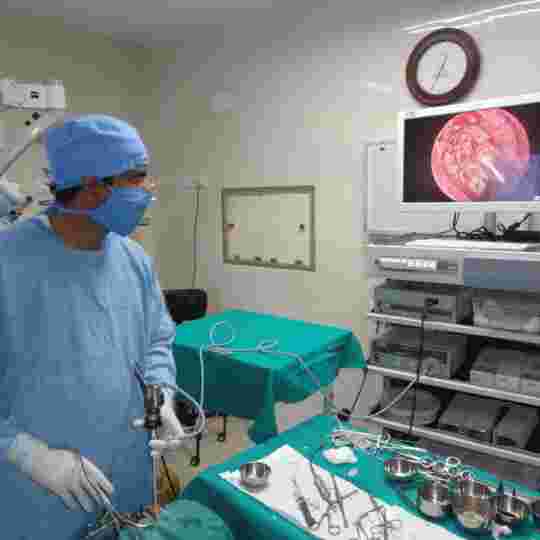Adenoid
What are adenoids
Adenoid is a mass of lymphatic tissue in the back of the nose behind the soft palate. Adenoids, which shrink by adolescence in most individuals, are designed to trap germs that enter through the nose. A person’s tonsils maintain a similar function, catching microscopic substances that come in via the mouth.
Surgery doesn’t compromise that line of defense: “Studies have shown that removal of the adenoid doesn’t adversely affect a body’s ability to fight off infection in the long run.
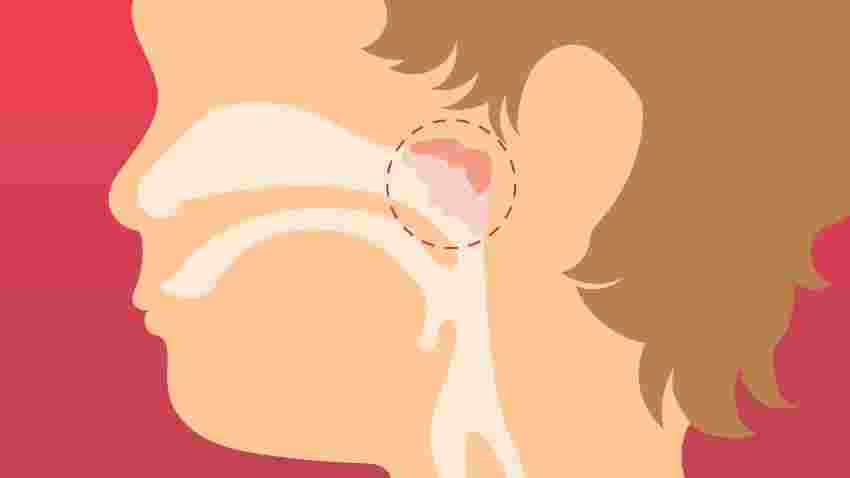
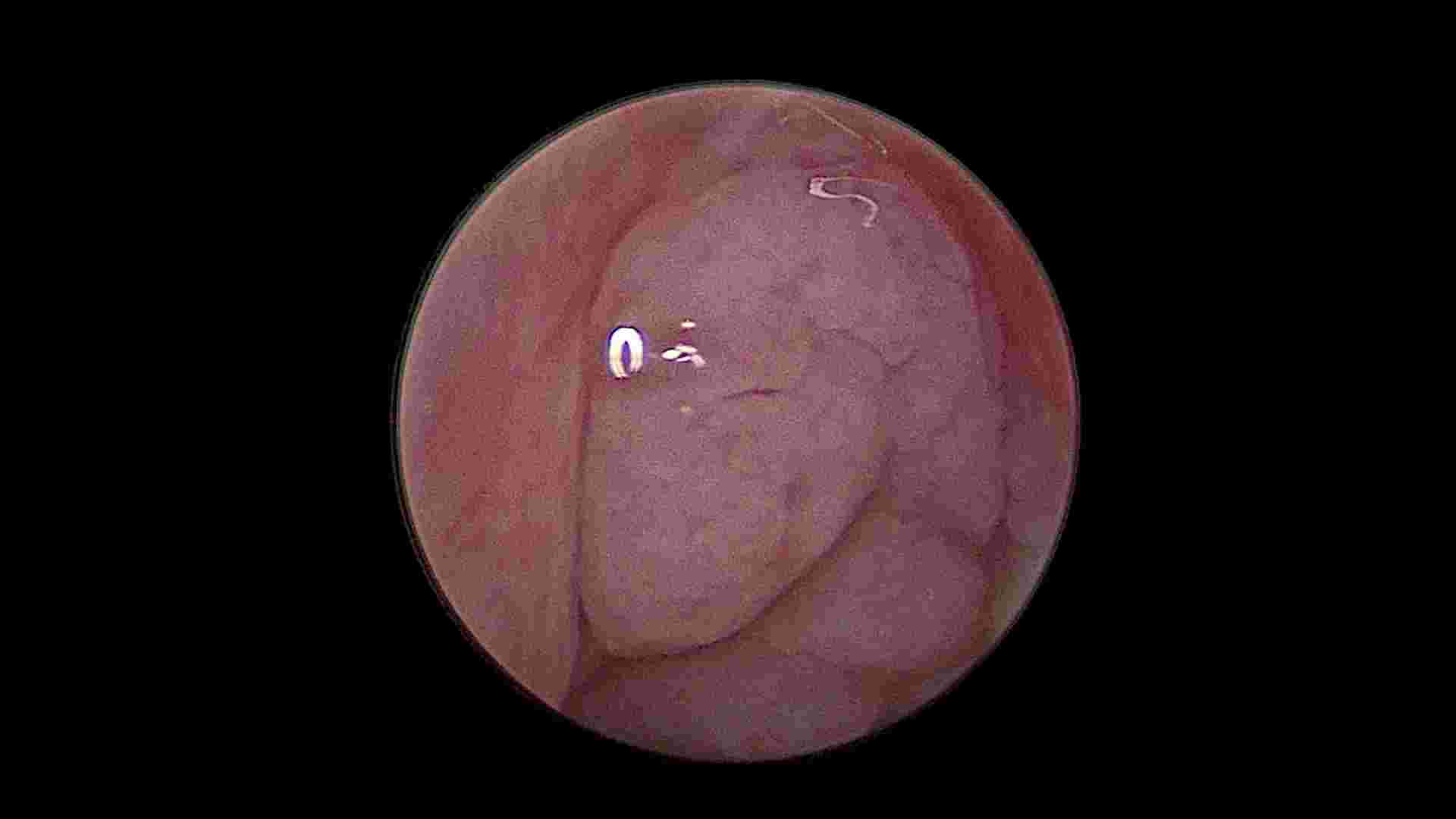
Image of large adenoid blocking region behind nose (nasopharynx) and Eustachian tube area
Why it’s done
Adenoidectomy may be advised when a child has persistent nasal obstruction, chronic ear or sinus infections, snoring / mouth breathing or sleep disturbance.
In most cases large adenoids in behind nose block Eustachian tube openings there by impeding ventilation to middle ear cavity. This causes a slow accumulation of serous discharge and later may get infected. This causes severe pain, decreased hearing in kids. If neglected kids ear drum may break and cause discharge from ear.
Surgery
We prefer a technology called coblation II device produced by smith and nephew. The COBLATOR II Surgery System is designed for ablation, resection, and coagulation of soft tissue and hemostasis of blood vessels in otorhinolaryngology (ENT) surgery. Using patented COBLATION technology, the system dissolves tissue at the molecular level in a highly-controlled manner with minimal thermal effect on surrounding tissue. We use The PROCISE◊ MAX COBLATION◊ Wand with rapid tissue removal for Adenoidectomy while maintaining the hemostatic and minimal thermal effect benefits of COBLATION technology. With integrated suction, ablation, and coagulation features this single-use device is an all-in-one instrument designed to help decrease surgical time.

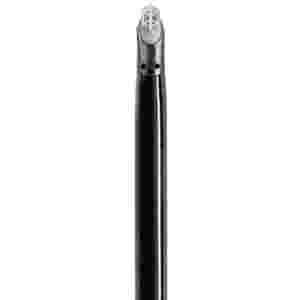
video clip of adenoidectomy using coblation II technology

CONNECT — Product Branding: — Serial Number: NT743788-P — Sales Number: TC200 — Part Number: 062364-06BA — SW (Tarball) Version: 471000-0130.BA Link 1 [H3-LINK] [Primary Source] — Product Branding: S — Serial Number: ZV726107-P — Sales Number: TC300 — Part Number: 062703-07BB — SW (Tarball) Version: 471001-0127.BC — Camera Head [Description: H3-Z SPIES; Serial Number: ZV844089-H] — Brightness: 3 — Special Features: [SPIES: Enabled,SPIES; Fiberscope Filter: Disabled; Enhancement: CLARA; Image Flip: None; Zoom: 1] Power LED 175 — Product Branding: Karl Storz — Serial Number: 6710 — Device ID: 2 — Device Type: 0x100e — Light Source: On — LS Mode: Auto — Max Intensity Auto: 100 — Intensity Manual: 25 — Exposure: 620

CONNECT — Product Branding: — Serial Number: NT743788-P — Sales Number: TC200 — Part Number: 062364-06BA — SW (Tarball) Version: 471000-0130.BA Link 1 [H3-LINK] [Primary Source] — Product Branding: S — Serial Number: ZV726107-P — Sales Number: TC300 — Part Number: 062703-07BB — SW (Tarball) Version: 471001-0127.BC — Camera Head [Description: H3-Z SPIES; Serial Number: ZV844089-H] — Brightness: 3 — Special Features: [SPIES: Enabled,SPIES; Fiberscope Filter: Disabled; Enhancement: CLARA; Image Flip: None; Zoom: 1] Power LED 175 — Product Branding: Karl Storz — Serial Number: 6710 — Device ID: 2 — Device Type: 0x100e — Light Source: On — LS Mode: Auto — Max Intensity Auto: 100 — Intensity Manual: 20 — Exposure: 608
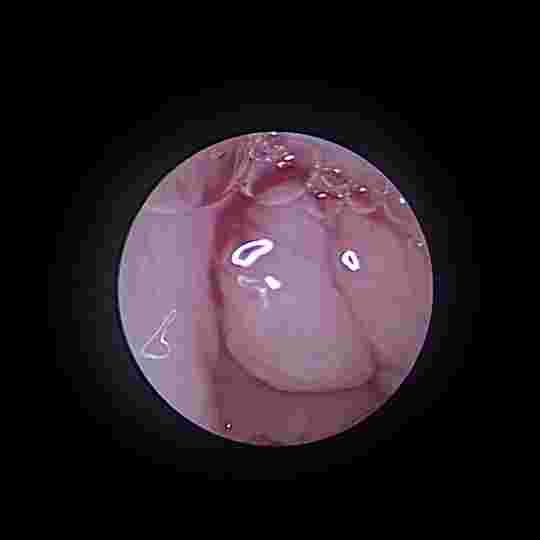
CONNECT — Product Branding: — Serial Number: NT743788-P — Sales Number: TC200 — Part Number: 062364-06BA — SW (Tarball) Version: 471000-0130.BA Link 1 [H3-LINK] [Primary Source] — Product Branding: S — Serial Number: ZV726107-P — Sales Number: TC300 — Part Number: 062703-07BB — SW (Tarball) Version: 471001-0127.BC — Camera Head [Description: H3-Z SPIES; Serial Number: ZV844089-H] — Brightness: 3 — Special Features: [SPIES: Enabled,SPIES; Fiberscope Filter: Disabled; Enhancement: CLARA; Image Flip: None; Zoom: 1] Power LED 175 — Product Branding: Karl Storz — Serial Number: 6710 — Device ID: 2 — Device Type: 0x100e — Light Source: On — LS Mode: Auto — Max Intensity Auto: 100 — Intensity Manual: 20 — Exposure: 525
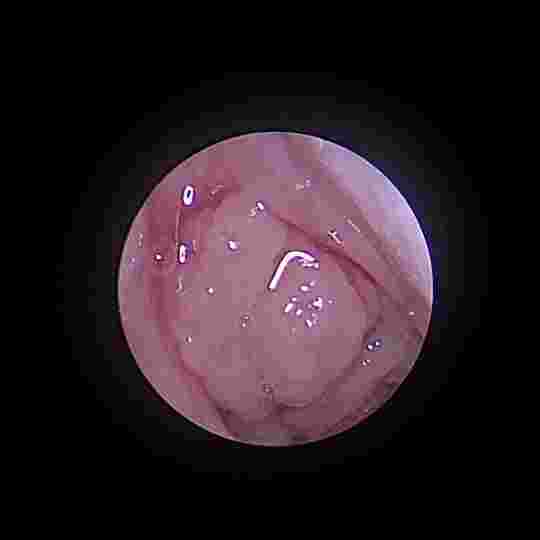
CONNECT — Product Branding: — Serial Number: NT743788-P — Sales Number: TC200 — Part Number: 062364-06BA — SW (Tarball) Version: 471000-0130.BA Link 1 [H3-LINK] [Primary Source] — Product Branding: S — Serial Number: ZV726107-P — Sales Number: TC300 — Part Number: 062703-07BB — SW (Tarball) Version: 471001-0127.BC — Camera Head [Description: H3-Z SPIES; Serial Number: ZV844089-H] — Brightness: 3 — Special Features: [SPIES: Enabled,SPIES; Fiberscope Filter: Disabled; Enhancement: CLARA; Image Flip: None; Zoom: 1] Power LED 175 — Product Branding: Karl Storz — Serial Number: 6710 — Device ID: 2 — Device Type: 0x100e — Light Source: On — LS Mode: Auto — Max Intensity Auto: 100 — Intensity Manual: 20 — Exposure: 573
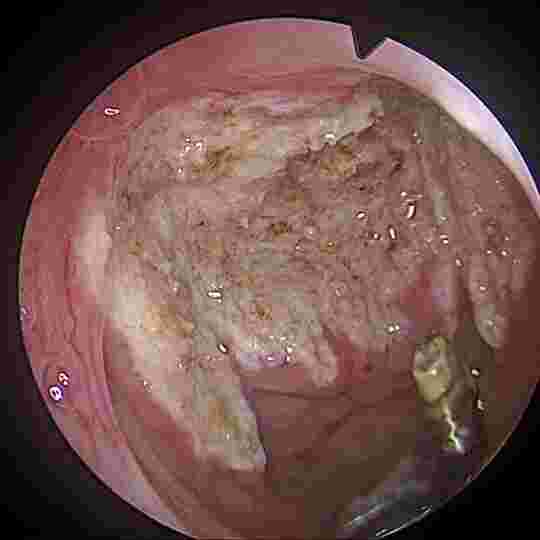
CONNECT — Product Branding: — Serial Number: NT743788-P — Sales Number: TC200 — Part Number: 062364-06BA — SW (Tarball) Version: 471000-0130.BA Link 1 [H3-LINK] [Primary Source] — Product Branding: S — Serial Number: ZV726107-P — Sales Number: TC300 — Part Number: 062703-07BB — SW (Tarball) Version: 471001-0127.BC — Camera Head [Description: H3-Z SPIES; Serial Number: ZV844089-H] — Brightness: 3 — Special Features: [SPIES: Enabled,SPIES; Fiberscope Filter: Disabled; Enhancement: CLARA; Image Flip: None; Zoom: 1] Power LED 175 — Product Branding: Karl Storz — Serial Number: 6710 — Device ID: 2 — Device Type: 0x100e — Light Source: On — LS Mode: Auto — Max Intensity Auto: 100 — Intensity Manual: 20 — Exposure: 570

CONNECT — Product Branding: — Serial Number: NT743788-P — Sales Number: TC200 — Part Number: 062364-06BA — SW (Tarball) Version: 471000-0130.BA Link 1 [H3-LINK] [Primary Source] — Product Branding: S — Serial Number: ZV726107-P — Sales Number: TC300 — Part Number: 062703-07BB — SW (Tarball) Version: 471001-0127.BC — Camera Head [Description: H3-Z SPIES; Serial Number: ZV844089-H] — Brightness: 3 — Special Features: [SPIES: Enabled,SPIES; Fiberscope Filter: Disabled; Enhancement: CLARA; Image Flip: None; Zoom: 1] Power LED 175 — Product Branding: Karl Storz — Serial Number: 6710 — Device ID: 2 — Device Type: 0x100e — Light Source: On — LS Mode: Auto — Max Intensity Auto: 100 — Intensity Manual: 20 — Exposure: 575
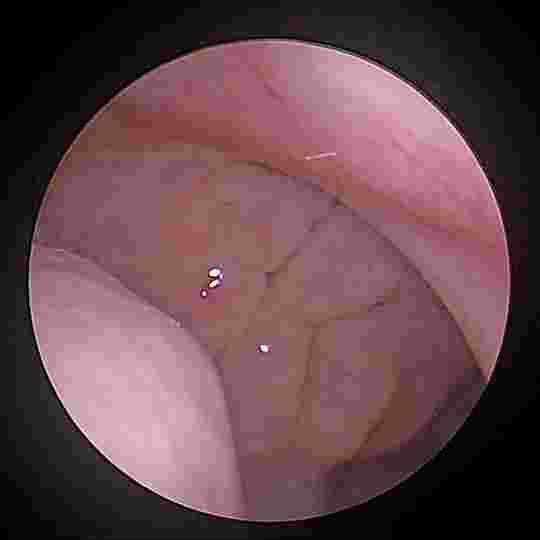
CONNECT — Product Branding: — Serial Number: NT743788-P — Sales Number: TC200 — Part Number: 062364-06BA — SW (Tarball) Version: 471000-0130.BA Link 1 [H3-LINK] [Primary Source] — Product Branding: S — Serial Number: ZV726107-P — Sales Number: TC300 — Part Number: 062703-07BB — SW (Tarball) Version: 471001-0127.BC — Camera Head [Description: H3-Z SPIES; Serial Number: ZV844089-H] — Brightness: 3 — Special Features: [SPIES: Enabled,SPIES; Fiberscope Filter: Disabled; Enhancement: CLARA; Image Flip: None; Zoom: 1] Power LED 175 — Product Branding: Karl Storz — Serial Number: 6710 — Device ID: 2 — Device Type: 0x100e — Light Source: On — LS Mode: Auto — Max Intensity Auto: 100 — Intensity Manual: 94 — Exposure: 558

CONNECT — Product Branding: — Serial Number: NT743788-P — Sales Number: TC200 — Part Number: 062364-06BA — SW (Tarball) Version: 471000-0130.BA Link 1 [H3-LINK] [Primary Source] — Product Branding: S — Serial Number: ZV726107-P — Sales Number: TC300 — Part Number: 062703-07BB — SW (Tarball) Version: 471001-0127.BC — Camera Head [Description: H3-Z SPIES; Serial Number: ZV844089-H] — Brightness: 1 — Special Features: [SPIES: Enabled,SPIES; Fiberscope Filter: Disabled; Enhancement: CLARA + CHROMA; Image Flip: None; Zoom: 1] Power LED 175 — Product Branding: Karl Storz — Serial Number: 6710 — Device ID: 2 — Device Type: 0x100e — Light Source: On — LS Mode: Auto — Max Intensity Auto: 100 — Intensity Manual: 20 — Exposure: 557
Pre and post op images-showing nasopharynx blocked by adenoid tissue in first row and second row showing post op wide nasopharynx with widened Eustachian tube ends.
What to expect in recovery
Compared with tonsillectomy, the healing process is often easier for adenoidectomy patients. “There’s typically less pain, less risk of bleeding and a quicker return to normal activities,”
Post-Operative Care Instructions
following instructions will help you know what to expect in the days following surgery. Do not, however, hesitate to call if you have any questions or concerns.
Physical Activities
After this surgery, children should rest but may play inside after 2-3 days and may be outside after 7 days, if they feel up to it. Strenuous physical activity following surgery is discouraged. Children may return to school after 5-7 days. Avoid dust exposure during 1st week.
Diet
No diet restrictions after discharge
Pain
Pain is nearly absent in most cases. Occasionally kids may complain of neck pain. Which will subside in 1-2 weeks.
Follow up
Arrange to see weekly once till 3 weeks after surgery.

Contact us
Bayya Hospitals
12-25-192, Bhagath Singh Centre, Kothapet, Guntur, Andhra Pradesh 522001
0863-2225729
+91 6304429294
+91 93819 22827
Useful Links
Consultation Hours
For ENT
Monday – Saturday 9AM – 1:30 Noon,
Evening 5:30PM to 8:00PM
Sunday – CLOSED
For EYE
Monday – Saturday 9AM – 5:00PM
Sunday – CLOSED

